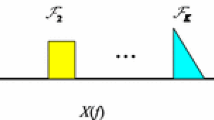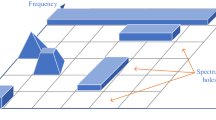Abstract
In differential frequency hopping (FH) wireless systems, data are expressed by frequency hopping pattern, and frequency detection involving the Fourier transform and widebands requires large numbers of Nyquist samples, which makes them difficult to implement. Due to the sparseness of FH signals in the frequency domain, compressive sampling (CS) techniques have been explored for the sampling and reconstruction of such signals. In CS, the number of measurements must satisfy \(M\ge {C}\cdot {\mu }^2(\varvec{\varPhi },\varvec{\varPsi })\cdot {K}\cdot {}log(N)\), where \(C\) and \(\mu (\varvec{\varPhi },\varvec{\varPsi })\) are the constants, \(K\) is the sparsity level, and \(N\) is the dimension of the original signal. Because of the large number of channels in the operation band, many of these channels are often occupied by diverse frequency-fixed (FF) signals. For this reason, the band compression rate (BCR \(=N/M\)) may be greatly reduced. However, the FH signals only occupy a single frequency at a time. This means that \(K=1\), and the number of measurements can be far smaller than the number to restore the mixture of FH and FF signals. In this paper, a CS method that is not subject to the influence is presented, and the BCR can reach 1,000:6 when the FH signal is mixed with 50 interferences. The proposed algorithm covers the generation of the sampling matrix and signal reconstruction. Specifically, it maximizes the signal-to-noise ratio of the compressed signal with a white noise background. The new reconstruction algorithm was found to be 5 times faster than the OMP algorithm in the case of that \(K=4\), and it is not limited by the inequality given above.





Similar content being viewed by others
References
E.J. Candes, J. Romberg, T. Tao, Robust uncertainty principles: exact signal reconstruction from highly incomplete frequency information. IEEE Trans. Inf. Theory. 52, 489–509 (2006)
E.J. Candes, T. Tao, Near-optimal signal recovery from random projections: universal encoding strategies. IEEE Trans. Inf. Theory. 52, 5406–5425 (2006)
E.J. Candes, T. Tao, Decoding by linear programming. IEEE Trans. Inf. Theory. 51, 4203–4215 (2006)
E.J. Candes, M.B. Wakin, An introduction to compressive sampling. IEEE Signal Process. Mag. 25, 21–30 (2008)
S.S. Chen, D.L. Donoho, M.A. Saunders, Atomic decomposition by basis pursuit. SIAM Rev. 43, 129–159 (2001)
L. Daudet, Sparse and structured decompositions of signals with the molecular matching pursuit. IEEE Trans. Audio Speech Lang. Process. 14, 1808–1816 (2006)
T.T. Do, T.D. Tran, L. Gan, Fast compressive sampling with structurally random matrices. ICASSP (2008). doi:10.1109/ICASSP.2008.4518373
D.L. Donoho, Compressed sensing. IEEE Trans. Inf. Theory 52, 1289–1306 (2006)
S. Florian, Y.M. Zou, L. Ying, Toeplitz block matrices in compressed sensing and their applications in imaging. Inf. Technol. Appl. Biomed. (2008). doi:10.1109/ITAB.2008.4570587
B. Hajek, P. Seri, Lex-optimal online multiclass scheduling with hard deadlines. Math. Oper. Res. 30, 562–596 (2005)
J. Haupt, W.U. Bajwa, G. Raz et al., Toeplitz compressed sensing matrices with applications to sparse channel estimation. IEEE Trans. Inf. Theory 56, 5862–5875 (2010)
F. Matthew, D.G. Mixon, J.C. Tremainc, Steiner equiangular tight frames. Linear Algebr. Appl. 436, 1014–1027 (2012)
D. Needell, J.A. Tropp, CoSaMP: iterative signal recovery from incomplete and inaccurate samples. Inf. Theory Appl. 26, 301–321 (2008)
D. Needell, R. Vershynin, Signal recovery from incomplete and inaccurate measurements via regularized orthogonal matching pursuit. Sel. Top. Signal Process. 4, 310–316 (2010)
Z. Ramin, P. Ali, K.P.C. Edwin, Robust Measurement design for detecting sparse signals: equiangular uniform tight frames and grassmannian packings, American Control Conference (Marriott Waterfront, Baltim, 2010), pp. 4070–4075
Z. Ramin, P. Ali, K.P.C. Edwin, Measurement design for detecting sparse signals. Phys. Commun. 5, 64–75 (2012)
W. Robert Jr et al., Grassmannian signatures for CDMA systems. Glob. Telecommun. Conf. 3, 1553–1557 (2003)
M. Rudelson, R. Veshynin, Geometric approach to error correcting codes and reconstruction of signals. Int. Math. Res. Not. 64, 4019–4041 (2005)
K. Schnass, P. Vandergheynst, Dictionary preconditioning for greedy algorithms. IEEE Trans. Signal Process. 56, 1994–2002 (2008)
M. Stojnic, W. Xu, B. Hassibi, Compressed sensing - probabilistic analysis of a null-space characterization. ICASSP (2008). doi:10.1109/ICASSP.2008.4518375
T. Strohmer, A note on equiangular tight frames. Linear Algebr. Appl. 429, 326–330 (2008)
M.A. Sustik, J.A. Tropp, I.S. Dhillon, R.W. Heath, On the existence of equiangular tight frames. Linear Algebr. Appl. 426, 619–635 (2007)
J.A. Tropp, Greed is good: algorithmic results for sparse approximation. IEEE Trans. Inf. Theory 50, 2231–2242 (2004)
W. Wang, M.J. Wainwright, K. Ramchandran, Information-theoretic limits on sparse signal recovery: dense versus sparse measurement matrices. IEEE Trans. Inf. Theory 56, 2967–2979 (2010)
Author information
Authors and Affiliations
Corresponding author
Rights and permissions
About this article
Cite this article
Wang, Lx., Zhang, Bz. & Zhao, Yz. Compressive Sampling and Rapid Reconstruction of Broadband Frequency Hopping Signals with Interference. Circuits Syst Signal Process 34, 1535–1547 (2015). https://doi.org/10.1007/s00034-014-9912-4
Received:
Revised:
Accepted:
Published:
Issue Date:
DOI: https://doi.org/10.1007/s00034-014-9912-4




